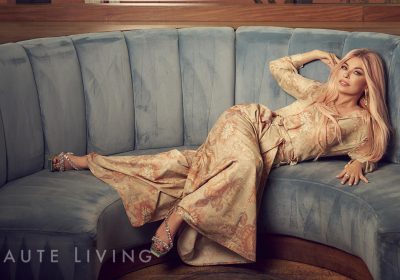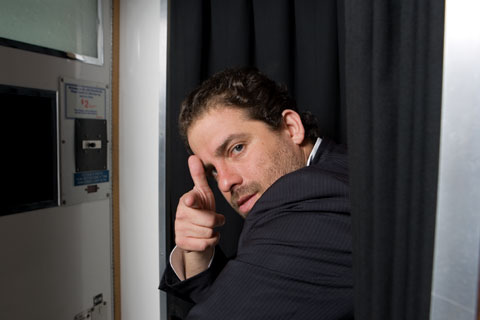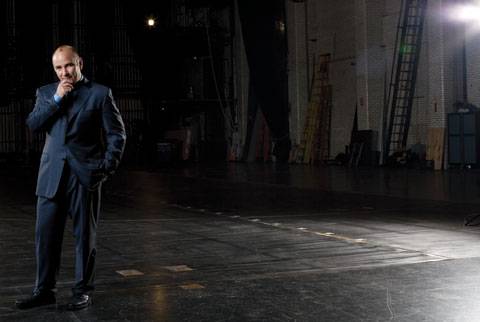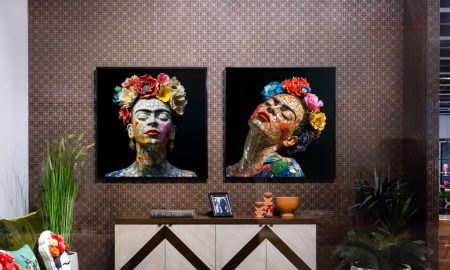Through a series of believe-it-if-you-can tales that altogether define his life, Brett Ratner tells the story of his rise from a $500 per week salary from The Forge to a billion dollar director taking over Hollywood, one industry at a time
By Kamal Hotchandani & Stephanie Wilson
Photography by Barry Peele
“He never was one to wait and see what life had in store for him, he made it happen.”
The mark of a good director is their ability to tell an intriguing tale. The world has no doubt that Brett Ratner can do just that. At the age of 38, his eight feature films have grossed more than a billion dollars worldwide, a number that is sure to increase exponentially with the August 10 release of Rush Hour 3. While many of his director counterparts spend their time hiding behind the camera, Brett Ratner is coming out in full force. He is creating more than just a name for himself in the world of directing. He is building a Ratner brand that is set to take over almost every sector of the entertainment industry. His companies have a hand in movies, television, music, and book publishing. His rise to the top of his industry is intriguing enough to be the subject of one of his blockbuster films. This is his story.
The Backstory
For Brett Ratner, his whole life has been about directing. “When you love something, it shows in your work,” he says. And the world knows that, without a doubt, Ratner loves directing. He has for as long as he can remember, spending the days growing up on Miami Beach stalking around the sets of Miami Vice and Scarface, even scoring a cameo as a background extra in the 1983 Brian De Palma film. Ratner was 13. So sure of his eventual career, he convinced his young mother to skip him forward in school. “I told my mom I was too smart for the kids in my class,” he recalls. “I think I went from second to fifth grade; I skipped third and forth grade. I wanted to be a director, and I thought, ‘Oh my God, I have to wait until I am 18? That’s half my life!'”
He has always had a flair for the dramatic.
It is a flair that served him well, as evidenced by the now-legendary tale of talking his way into film school when he was just 16. (The story has Ratner turning up at the dean’s office after receiving a rejection letter, pleading, “If you don’t let me in, I’ll spend the rest of my life on my mom’s couch.” He received an acceptance letter two weeks later.) That story, while full of cinematic drama, may have been stretched from the truth, which is that Ratner’s family was good friends with Miami Beach Police Chief Rocky Pomerance, who was great friends with the Tisch Family (think The Tisch School of Arts at NYU). “I think I was the Ferris Bueller of Miami Beach; I had the whole place just wired,” he says with a laugh from the comfort of his California estate.
While he may have found extreme levels of success on the West Coast, he credits it all to Miami Beach.
“I can say I had the best childhood experience ever growing up in Miami Beach,” he explains. He says he was “exposed to so many kinds of people” that helped him grow into the success tale he is today, beginning with his maternal grandparents, Mario and Fanita Presman, and his mother, Marsha. The family all lived together in Miami Beach throughout Ratner’s childhood. His paternal grandfather, Lee Ratner, a mega-developer responsible for the naming of Lee County in Southwest Florida, was also a constant influence and inspiration. Ratner owned a home on North Bay Road, where Al Malnik was known to visit. Malnik became the closest father figure to Ratner, and his son Shareef became like a brother.
Malnik urged Ratner to attend law school and become a studio head to capitalize on making 20 pictures a year as opposed to one per year as a director; Brett obliged him so far as studying for the entrance exam in exchange for the funding of a short film. Brett laughs, “One motivation [for Al funding the film] was to help me, and the other was to get more acquainted with Nancy Gresham.” Brett cast Nancy in the film, and Al went on to marry her.
Prior to film school, Ratner honed his directing skills using the characters that populated the Beach, making Miami Vice meets Kung Fu-type flicks. “I would make little films with my Super-8 camera, but all the actors would be all the old people, because it was only old people in Miami Beach then,” he laughs. “So I made dozens of these little films with these old actors or my family.”
Ratner can claim some responsibility in the transformation of Miami Beach from a geriatric haven into an international haute spot. When Bruce Weber came to town in 1985 to shoot a Calvin Klein campaign, the Beach was suddenly crawling with models with nothing to do. It was Ratner and Shareef to the rescue. “We started inviting the models [to The Forge], and it was just me and Shareef with twenty girls all of a sudden,” Brett recalls. “My three best friends were Anthony Michael Hall [The Breakfast Club, Sixteen Candles], Pauly Shore, and Matt Dillon, and I said, ‘Come down to Miami!’ So Anthony Michael Hall, myself, and all these pretty young models are having dinner and all of a sudden, everyone that came down to Miami would come to The Forge.” Brett got on the payroll, earning $500 per week for his efforts turning the restaurant into a must-see on Miami Beach. The Forge, now owned by Shareef, still reigns supreme as the place to go for sophisticated Miami Beach nightlife.
The Scene
Much of Ratner’s current story takes place at the filmmaker’s home, Hillhaven Lodge, in Beverly Hills, California. The history of the location is as captivating as its current owner. The English country mansion was designed by Gordon Kaufman, the same great mind responsible for the Hoover Dam. Hillhaven was built in 1923 and has since passed through the hands of many Hollywood greats like Allan Carr, producer of Grease, James Caan of Godfather-fame, and starlet Ingrid Bergman before ending up in Ratner’s possession. “I walked in [to Hillhaven Lodge],” recalls Brett, “and was like ‘This is my house.’ I couldn’t afford it, but I was like, ‘This is my house.'” It could be the disco in the basement built by Carr in the 70s, or the location at the end of a private road that affords privacy to its owner, but whatever the reason, he had to have it.
With his home filled with photographic artwork from Helmut Newton and Peter Beard, Ratner explains, “I think photography is really the art of the future because most people can’t afford the works of the traditional masters.” The home is infused with works by Warhol and Rodin, and collectible furniture by Prouvé. The beautiful works complete the feel of the mansion, which has been restored to its original condition.
As evidenced by the coffee table book The Hillhaven Lodge: The Photo Booth Pictures, published in 2003, everyone who’s anyone has made their way to casa Ratner. The book is filled with black and white filmstrips from Ratner’s famed photo booth, portraying goofy shots of everyone from Michael Jackson and Britney Spears to legendary producers such as Robert Evans and Dino De Laurentiis. The Lodge has been known to be a playground for the likes of Paris and Lindsay, as well as a more sophisticated crowd- even recently hosting a Hillary Clinton event, followed by a John Edwards fundraiser.
The Characters
The people who surround Ratner make for an all-star cast. From his mentor Al Malnik (“Al is my mentor on life, my mentor in business, and he even helps choose the movies I make,” he says) to his friends Bob Evans, Russell Simmons, Warren Beatty, Shareef Malnik, Jeff Soffer, and George Pérez, Brett has constantly surrounded himself with extremely successful individuals he can learn from.
“I didn’t pick their brain, I ate their brain,” he says of everyone he would meet. “I would always ask questions. ‘How did you do it? How did you reach your success?’ And all I did was apply it to what I wanted to do, which was make a movie.”
One such mentor is producer Bob Evans, who took Ratner under his wing upon Ratner’s arrival in Hollywood. “I met Brett when he came into town during Rush Hour, and I immediately took an interest in him because he is dynamic, positive, likeable, and a terribly, terribly serious worker with the outside veneer of a kid. The inside of his body and brain is that of a brilliant film maker,” says Evans. Ratner even resided with Evans for a period of time before purchasing Hillhaven. It was Evans’ “old school Hollywood” house that prompted Ratner to go on a hunt for a home like Hillhaven. After seeing Evans’ place, Ratner says, “I called [Evans’] broker, and he said ‘Those houses don’t become available unless someone dies.’ So I moved into the Beverly Hills Hotel and stayed there for six months-cost me a fortune! And then I get a call, and he says, ‘Somebody died, get over here!'”
“Brett is a dynamic and unstoppable force of nature!” says George Pérez, president of Turnberry International Realty. “He never was one to wait and see what life had in store for him, he made it happen. We go back twenty-five years, and despite all of his successes, his love for family, the loyalty he shares with his friends, and his insatiable passion for life have always remained the focal points of his character.”
The Plot
The story opens up with Ratner and Russell Simmons at a Def Comedy Jam. Ratner had been cutting his teeth directing music videos. Chris Tucker, a then-unknown comic, performs, and catches Ratner’s eye. Ratner casts him in a Heavy D video for $500 pay plus agreeing to let him keep his wardrobe. The video came out as a huge hit, and Tucker went on to make Friday. He was about to do Money Talks and the director went to the head of the studio and tried to get Tucker fired. Ratner explains, “The head of the studio said, ‘You’re fired, we are not losing Chris Tucker!’ because the director said, ‘I can’t control him,’ and it’s the director’s job to control the talent.” Tucker remembered Ratner from the video and recommended him for the job of director. The movie cost $20 million and went on to make $40 million. Ratner was just 26 years old.
The rest is cinematic history. He cast Tucker alongside martial arts maven Jackie Chan in Rush Hour, crediting being exposed to the unique mix of cultures at Miami Beach High for the unlikely combination. “The movie just took off,” Ratner says. It cost $33 million to make and went to gross over $200 million worldwide. Ratner reaped in the success, becoming a ‘first dollar gross director’ (industry term meaning he gets 10 cents for every dollar that goes into the movie theater before the studio even recoups their losses from a film). Rush Hour 2 followed in its footsteps in 2001, grossing $350 million worldwide. Rush Hour 3 premiered worldwide on August 10, taking in $50.2 million in the opening weekend alone.
Ratner has gone on to direct eight movies in different genres, including last year’s X-Men: The Last Stand and 2002’s Red Dragon. It is a level of success that still makes him giddy. “It’s beyond my wildest dreams… to be a billion dollar director-for me, I would have been happy making little movies with the same friends.” Not that one would believe him for a second. He has been driven to success since his days as a boy on Miami Beach. He has chased his dreams, and succeeded beyond expectations. “I remember being a kid and watching Batman and wanting to make a movie like that and then-Oh my God-I make X-Men, a two hundred million dollar production, which is bigger than Batman ever was in scope and size. Then at the age of twenty, I am watching Silence of the Lambs and then I’m directing Red Dragon with Anthony Hopkins as Hannibal Lecter. That’s when I had to pinch myself, because I always knew I was going to be a director, but I didn’t ever realize the scope of my films’ abilities.”
And… Action!
Brett is constantly busy, whether with his films, television shows, music videos, or various causes. Growing up on Miami Beach next to Al Malnik, Ratner was influenced by Malnik’s charitable giving. Today, he follows in Malnik’s footsteps, choosing to give time in addition to money. “My awareness of philanthropy has been heavily influenced by Al,” he says. “So I kind of want to set an example and inspire young people to give back…. I think it’s important for people with a lot of success.” He is actively involved with the Museum of Tolerance and Chrysalis.
But his main love is being behind a camera, movie or otherwise. He is now an acclaimed photographer responsible for the striking Jimmy Choo ads with Nicole Ritchie, and the stunning shots of Heidi Klum for Jordache. “I do it because I’m a storyteller… I grew up as a kid making films, trying to tell stories. And I like the challenge of telling a story with one picture.”
It is a talent that he has embraced. His knowledge and enthusiasm about the business has allowed him to grow from your run-of-the-mill director into an unstoppable business mogul with near countless projects on the horizon. “I have Rat Entertainment, which is where I make the movies I direct and produce. It is part of New Line Cinema, which is a Time Warner company. Rat Television, which produces shows for Fox Broadcasting, is my TV arm.” Under Rat Television, he has produced Prison Break, with Women’s Murder Club coming out this season. He is a judge on Spielberg’s reality show On the Lot, and was recently featured as himself on the HBO hit series Entourage. He has a hand in virtually every aspect of entertainment, even going so far as to pick all the music used on his soundtracks. He has invested an undisclosed amount in Fountainebleau Las Vegas with childhood friend Jeff Soffer. His next step is announcing that he has a way to finance not only his films, but also those of young up-and coming directors. He is so much more than just a director; he is a full-fledge brand that is making its mark on American culture.
The Hollywood rumor mill has been in full swing with talk of Ratner directing a biography of Playboy founder Hugh Hefner. Flashback to his childhood in Florida, watching his mentors, Don Soffer and James Caan, out on Soffer’s boat: “I remember times Jeff [Soffer] and I would go spy on them,” he says, “and they would be on the Monkey Business with all the Playmates. And we’d say, ‘Oh my God! One day…'” It seems that day is today. And it shouldn’t be long before the rest of Ratner’s dreams come true as well.





















